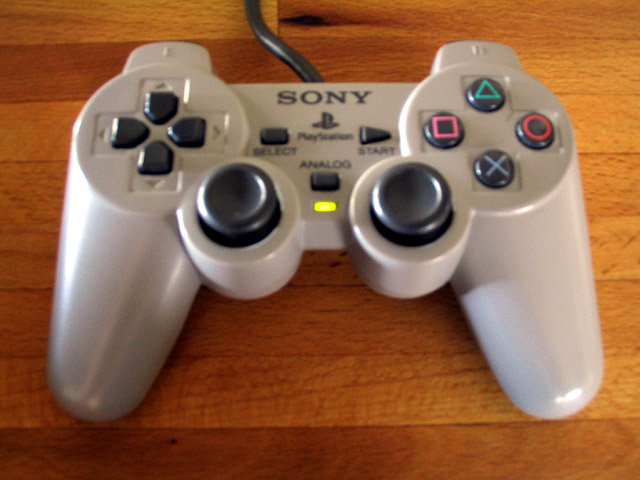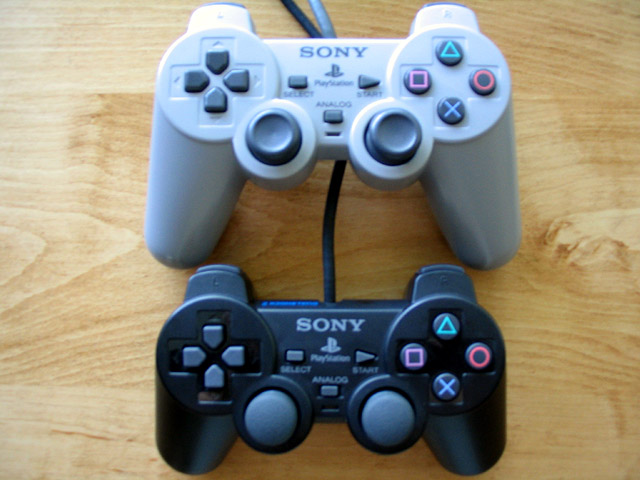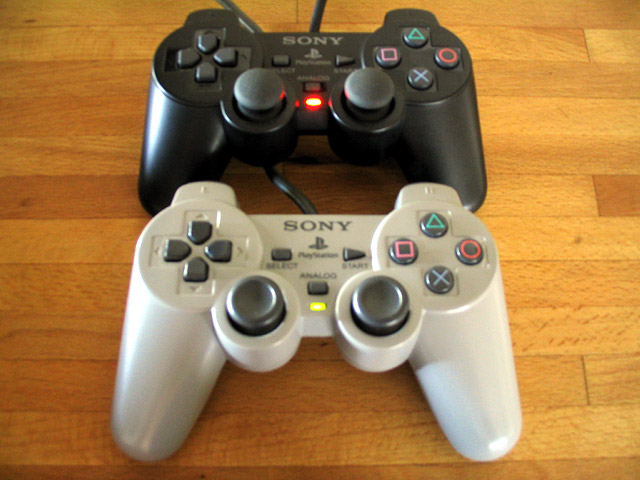

| |
05/04/04 |
| Was this long-lost relative of the Dual Shock a better controller? |
 The Playstation Dual Shock has become an industry standard for gamers, but many might not know that it wasn't Sony's first attempt at an analog controller with thumbsticks. That honor goes to the long-forgotten "Dual Analog Pad," model# SCPH-1180, released in the U.S. in August of 1997. Its design was subsequently retooled to become the ubiquitous Dual Shock (SCPH-1200), which replaced it less than a year later in May of 1998. The Dual Shock model became the pack-in with new PlayStations, and its same design was later used for the PS2's Dual Shock 2 as well (with the addition of analog fuctionality to the face buttons). Meanwhile, the Dual Analog Pad (DAP) was quietly discontinued and never heard from again. But was the Dual Shock really an improvement over it in every regard? At first glance, the controllers don't look too different. The stick placement, buttons, and overall shape are all the same. But put them next to one another, and the first thing you notice is how much longer the DAP's handles are. Nearly a full inch of extra plastic makes for a big difference in how it sits in the hand. The result is a better grip and greater flexibility in positioning your thumbs to use combinations of the D-pad, buttons, and sticks.  The most dramatic difference between the Dual Analog Pad and the Dual Shock is the length of the handles. Instead of having a rubber coating, the DAP's thumbsticks sport a smooth plastic surface with concave depressions to keep your thumbs in place. The R2 and L2 shoulder buttons have a small ridge on their upper edge so that your fingers can easily tell where they begin underneath R1 & L1. Though the Japanese version of the DAP offered rumble vibration similar to the Dual Shock's, this feature was inexplicably removed from DAP in the U.S. Perhaps no domestic software supported feedback yet? The analog button in the center was made smaller and depressed on the Dual Shock, probably so that it's not as easy to inadvertantly hit during gameplay. Which brings us to an interesting feature seen only on the DAP: its "green mode." The Sony Dual Analog Pad had three modes that could be toggled with the analog button: digital, analog ("red mode"), and analog flight-stick emulation ("green mode"). The first two should be familiar to anyone who's picked up a Dual Shock: digital mode meant that the thumbsticks were completely disabled (the default mode for playing early games designed for the D-pad), and the analog mode was used with thumbstick-compatible games - now the standard method of control for the PS2. As with the Dual Shock, a red LED lights up in analog mode to indicate power to the thumbsticks.  The DAP's flight-stick emulation "green mode" was removed from the Dual Shock. But when the analog button is pressed a second time, the LED switches from red to green (gasp), and the two thumbsticks can be used as a miniature substitute for the Dual Analog Flightstick. The Flightstick was another obscure, short-lived Sony controller that predated the DAP. Its high price tag ($70) and limited software support doomed the peripheral to an even smaller manufacturing run, but that's another story. Suffice it to say that the DAP's green mode was a means of keeping the functionality of the Flightstick alive a little longer, and allowed it to support Flightstick-compatible PSone games like MechWarrior 2, Ace Combat 2, Descent Maximum, and Colony Wars. If you've ever envisioned a Dual Shock's thumbsticks being used for a twin joystick game like Sega's Virtual On series, you have an idea of what the DAP's green mode was intended to do. Unfortunately, in practice it didn't work out so well - mainly because two huge joysticks that you can wrap your fists around control very differently from two tiny thumbsticks. Sony eventually decided that so few titles were made for the Flightstick that the mode wasn't worth keeping, and stripped support from the refined Dual Shock design the following year. And that pretty green LED was lost to PlayStation controllers forever.  Many gamers preferred the feel of the DAP's significantly longer handles. So which one is better: the DAP or the Dual Shock? Tough call. The one clear advantage that the DAP has are its extra-long handles, and there's a faction of diehard gamers who swear by it for that alone. It really does provide a significantly more comfortable grip, especially for people with larger hands. One reason Sony likely reduced the controller's size was to take advantage of economies of scale: two inches less plastic on each controller adds up to a substantial savings when you're making millions of them. Another factor is that Japanese gamers are said to prefer their controllers smaller than the average American does; an example of this is the dramatic disparity between the size of the original Xbox pad in the U.S. and Asian markets. Incidentally, that's another case of a large controller that ended up getting replaced worldwide by a smaller revised version (the Xbox Type S). Otherwise, the Dual Shock was an improvement on the DAP, particularly in the response of the analog sticks themselves and in adding rumble support (absent from the American DAP). The thumbsticks of the DAP are a bit loose and don't have as much resistence, and the concave plastic surface doesn't hold a thumb in place as well as a rounded rubber grip does. It's sometimes hard to make precise movements with the DAP's wobbly thumbsticks. If Sony had combined the big handles of the DAP with the rest of the Dual Shock, it would have been the best of both worlds. As for the elimination of the green mode, it's not that much of a loss in practice. Besides the novelty of that green LED, there was never much to it. The few games that supported the green mode are unremarkable, and the DAP's thumbstick emulation never worked that well as a substitute for the Flightstick anyway. But it still looks cool! As a final note, nowadays the DAP may be one of the scarcest official first-party controllers ever made. Finding one isn't easy. New copies vanished from shelves long ago, and the used controller market is a difficult one to comb through. A recent search through eBay, online game retailers, and local game stores didn't turn up a single pad. And because it looks so similar to the Dual Shock, the few sellers who do happen to have one may not correctly identify it in online listings. The good news is that if you do manage to score a DAP, it's likely to sell cheap despite its rarity, so your wallet won't have to go into a "green mode" of its own. |